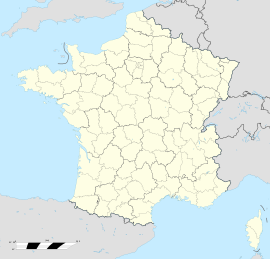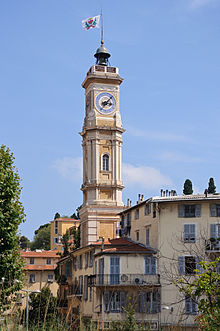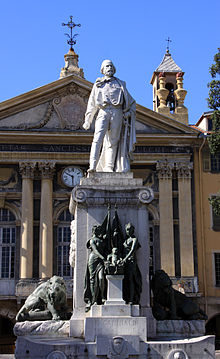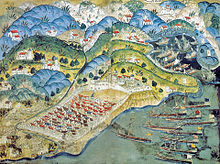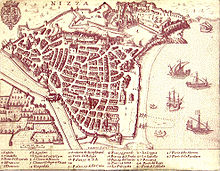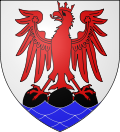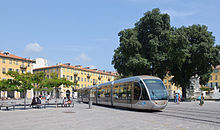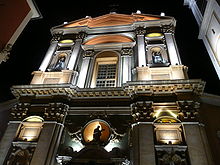- Nice
-
This article is about the French city. For other uses, see Nice (disambiguation)."Nizza" redirects here. For other uses, see Nizza (disambiguation).
Nice
Motto: Nicæa civitas.



Flag of the County of Nice Coat of arms of the County of Nice Administration Country France Region Provence-Alpes-Côte d'Azur Department Alpes-Maritimes Arrondissement Nice Intercommunality Nice-Côte d'Azur Mayor Christian Estrosi
(2008–14)Statistics Land area1 71.92 km2 (27.77 sq mi) Population2 344,875 (2008) - Ranking 5th in France - Density 4,795 /km2 (12,420 /sq mi) 1 French Land Register data, which excludes lakes, ponds, glaciers > 1 km² (0.386 sq mi or 247 acres) and river estuaries. 2 Population without double counting: residents of multiple communes (e.g., students and military personnel) only counted once. Coordinates: 43°42′12″N 7°15′59″E / 43.703393°N 7.266274°E
Nice (
 /ˈniːs/, French pronunciation: [nis]; Niçard Occitan: Niça [classical norm] or Nissa [nonstandard], Italian: Nizza or Nizza Marittima, Greek: Νίκαια, Latin: Nicaea) is the fifth most populous city in France, after Paris, Marseille, Lyon and Toulouse, with a population of 348,721 within its administrative limits on a land area of 71.92 km2 (28 sq mi). The urban area of Nice extends beyond the administrative city limits with a population of more than 955,000[1] on an area of 721 km2 (278 sq mi). Located on the south east coast of France on the Mediterranean Sea, Nice is the second-largest French city on the Mediterranean coast.
/ˈniːs/, French pronunciation: [nis]; Niçard Occitan: Niça [classical norm] or Nissa [nonstandard], Italian: Nizza or Nizza Marittima, Greek: Νίκαια, Latin: Nicaea) is the fifth most populous city in France, after Paris, Marseille, Lyon and Toulouse, with a population of 348,721 within its administrative limits on a land area of 71.92 km2 (28 sq mi). The urban area of Nice extends beyond the administrative city limits with a population of more than 955,000[1] on an area of 721 km2 (278 sq mi). Located on the south east coast of France on the Mediterranean Sea, Nice is the second-largest French city on the Mediterranean coast.The city is called Nice la Belle (Nissa La Bella in Niçard), which means Nice the Beautiful, which is also the title of the unofficial anthem of Nice, written by Menica Rondelly in 1912. Nice is the capital of the Alpes Maritimes département and the second biggest city of the Provence-Alpes-Côte d'Azur region after Marseille.
The area of today’s Nice is believed to be among the oldest human settlements in Europe. One of the archaeological sites, Terra Amata, displays evidence of a very early use of fire. Around 350 BC, Greeks of Marseille founded a permanent settlement and called it Nikaia, after Nike, the goddess of victory.[2]
Down the ages, the town changed hands many times. Its strategic location and port significantly contributed to its maritime strength. For years it was an Italian dominion, then became part of France in 1860. Culturally and architecturally enriched over time, today Nice has become a truly cosmopolitan tourist destination.[3] The spectacular natural beauty of the Nice area and its mild Mediterranean climate came to the attention of the English upper classes in the second half of the 18th century, when an increasing number of aristocratic families took to spending their winter there. The city’s main seaside promenade, the Promenade des Anglais (‘the Walkway of the English’) owes its name to the earliest visitors to the resort.[4] For decades now, the picturesque Nicean surroundings have attracted not only those in search of relaxation, but also those seeking inspiration. The clear air and soft light has been of particular appeal to some of Western culture’s most outstanding painters, such as Marc Chagall, Henri Matisse, Niki de Saint Phalle and Arman. Their work is commemorated in many of the city’s museums, including Musée Marc Chagall, Musée Matisse and Musée des Beaux-Arts Jules Chéret.[5] The climate and landscape are still what attracts most visitors today. It has the second largest hotel capacity in the country[6] and it’s the second-most visited place in France after Paris, receiving 4 million tourists every year.[7] It also has the second busiest airport in France after Paris[8] and two convention centres dedicated to business tourism. The city also has a university, several business districts and some major cultural facilities, such as museums, a national theatre, an opera house with a regional library and several concert halls and casinos. It is the historical capital city of the County of Nice (Comté de Nice).
Nice experiences a Mediterranean climate. The summer's/holiday season lasts for 6 months, from May to October, although also in April and November sometimes there are temperatures above 20 °C (68 °F). Winters are mild, with average temperatures of 13.4 °C (56.1 °F) during the day and 5.8 °C (42.4 °F) at night in the period from December to February.
Contents
History
Foundation
Main article: Greeks in pre-Roman GaulThe first known hominid settlements in the Nice area date back approximately 400,000 years;[9] the Terra Amata archeological site shows one of the earliest uses of fire and construction of houses and flint findings are dated as around 230,000 years old.[10] Nice (Nicaea) was probably founded around 350 BC by the Greeks of Massilia (Marseille), and was given the name of Νικαία ("Nikaia") in honour of a victory over the neighbouring Ligurians (Nike is the Greek goddess of victory). The city soon became one of the busiest trading ports on the Ligurian coast; but it had an important rival in the Roman town of Cemenelum, which continued to exist as a separate city until the time of the Lombard invasions. The ruins of Cemenelum are located in Cimiez, which is now a district in Nice.
Early development
See also: Roman Catholic Diocese of NiceIn the 7th century, Nice joined the Genoese League formed by the towns of Liguria. In 729 the city repulsed the Saracens; but in 859 and again in 880 the Saracens pillaged and burned it, and for most of the 10th century remained masters of the surrounding country.
During the Middle Ages, Nice participated in the wars and history of Italy. As an ally of Pisa it was the enemy of Genoa, and both the King of France and the Emperor endeavoured to subjugate it; but in spite of this it maintained its municipal liberties. During the course of the 13th and 14th centuries the city fell more than once into the hands of the Counts of Provence, but finally remained independent even if related to Genoa.
Nice and Savoy
In 1388 the commune placed itself under the protection of the Counts of Savoy. Nice participated – directly or indirectly – in the history of Savoy up until 1860.
The maritime strength of Nice now rapidly increased until it was able to cope with the Barbary pirates; the fortifications were largely extended and the roads to the city improved. In 1561 Emmanuel Philibert, Duke of Savoy, abolished the use of Latin as an administrative language and established the Italian language as the official language of government affairs in Nice.
During the struggle between Francis I and Charles V great damage was caused by the passage of the armies invading Provence; pestilence and famine raged in the city for several years. It was in the nearby town of Villeneuve-Loubet that the two monarchs in 1538 concluded, through the mediation of Pope Paul III, a truce of ten years.[11]
In 1543, Nice was attacked by the united Franco-Ottoman forces of Francis I and Barbarossa Hayreddin Pasha, in the Siege of Nice; and, though the inhabitants repulsed the assault which succeeded the terrible bombardment, they were ultimately compelled to surrender, and Barbarossa was allowed to pillage the city and to carry off 2,500 captives. Pestilence appeared again in 1550 and 1580.
In 1600, Nice was briefly taken by the duke of Guise. By opening the ports of the county to all nations, and proclaiming full freedom of trade (1626), the commerce of the city was given great stimulus, the noble families taking part in its mercantile enterprises.
Captured by Nicolas Catinat in 1691, Nice was restored to Savoy in 1696; but it was again besieged by the French in 1705, and in the following year its citadel and ramparts were demolished.
The treaty of Utrecht in 1713 once more gave the city back to the Duke of Savoy who was on that same occasion recognized as King of Sicily. In the peaceful years which followed the "new town" was built. From 1744 till the peace of Aix-la-Chapelle (1748) the French and Spaniards were again in possession. In 1775 the king, who in 1718 had swapped his sovereignty of Sicily for the Kingdom of Sardinia, destroyed all that remained of the ancient liberties of the commune. Conquered in 1792 by the armies of the First French Republic, the County of Nice continued to be part of France until 1814; but after that date it reverted to the Kingdom of Sardinia-Piedmont.
By a treaty concluded in 1860 between the Sardinian king and Napoleon III, the County was again ceded to France as a territorial reward for French assistance in the Second Italian War of Independence against Austria, which saw Lombardy unified with Piedmont-Sardinia. The cession was ratified by over 25,000 electors out of a total of 30,700. Savoy was also transferred to the French crown by similar means.
Giuseppe Garibaldi, born in Nice, strongly opposed the cession to France (arguing that the ballot was rigged by the French). Italian irredentists considered Nice one of their main nationalist goals, along with Istria, Dalmatia, Corsica and the South Tyrol. In 1942–1943 the city was occupied and administered by Italy during World War II.
French Nice
Since 1861 Nice has been part of France.
The 20th century saw the arrival of modern transportation. In 1900, the Tramway de Nice electrified its horse drawn streetcars and spread its network to the entire department from Menton to Cagnes-sur-Mer. By the 1930s additional bus connections added to the transportation network of the entire area.
In the 1930s Nice hosted international car racing in the Formula Libre (predecessor to Formula One) on the so-called Circuit Nice. The circuit started along the waterfront just south of the Jardin Albert I, then headed westward along the Promenade des Anglais followed by a hairpin turn at the Hotel Negresco to come back eastward and around the Jardin Albert I before heading again east along the beach on the Quai des Etats-Unis.
As war broke out in September 1939, Nice became a city of refuge for many displaced foreigners, notably Jews fleeing the Nazi progression into Eastern Europe. From Nice many sought further shelter in the French colonies, Morocco and North and South America. After July 1940 and the establishment of the Vichy Regime, antisemitic aggressions accelerated the exodus, starting in July 1941 and continuing through 1942. On 26 August 1942, 655 Jews of foreign origin were rounded up by the Laval government and interned in the Auvare barracks. Of them, 560 would be deported to Drancy internment camp on 31 August 1942. Thanks to the activity of the Jewish banker Angelo Donati and of the Capuchin friar Père Marie-Benoît the local authorities hindered the applications of anti Jewish Vichy laws.[12]
The first ”résistants” to the new Regime were a group of High School seniors of the Lycée de Nice, now Lycée Masséna, in September 1940, later arrested and executed in 1944 near Castellane. The first public demonstrations occurred on 14 July 1942 when several hundred protesters took to the streets along the Avenue de la Victoire and Place Masséna. After November 1942 and the arrival of Italian troops occupying the city, a certain ambivalence remained among the population, many recent immigrants of Italian ancestry. However, the resistance gained momentum after the Italian surrendered in 1943 when the German armies occupied Vichy France. Reprisals intensified between December 1943 and July 1944 when many partisans were tortured and executed by the local Gestapo and the French Milice. Nice was also heavily bombarded by the American aviation in preparation for the Allied landing in Provence (1000 dead or wounded and more than 5600 people homeless) and famine ensued in the course of the summer of 1944. Finally American paratroopers entered the city on 30 August 1944 and Nice was finally liberated. The consequences of the war were heavy, the population decreased by 15% and the economic life was totally disrupted.
In the second half of the 20th century, Nice enjoyed an economic boom primarily driven by tourism and construction. Two men dominated this period: Jean Médecin, mayor for 33 years from 1928 to 1943 and from 1947 to 1965 and his son Jacques, mayor for 24 years from 1966 to 1990. Under their leadership, the city experienced extensive urban renewal and new constructions were undertaken (Convention centre, theatres, new thoroughfares and expressways, etc.) The arrival of the Pieds-Noirs, refugees from Algeria after 1962 independence, also gave the city a boost and somewhat changed the make-up of its population and traditional views. By the late 1980s, rumors of political corruption in the city government surfaced and eventually formal accusations against Jacques Médecin forced him to flee France in 1990. Later arrested in Uruguay in 1993, he was extradited back to France in 1994, convicted of several counts of corruption and associated crimes and sentenced to imprisonment.
On 16 October 1979, a tsunami, caused by an undersea landslide hit the western coast of Nice and 23 people died.
In February 2001, European leaders met at Nice to negotiate and sign what is now the Treaty of Nice amending the institutions of the European Union.
In 2003, local Chief Prosecutor Éric de Montgolfier alleged that some judicial cases involving local personalities had been suspiciously derailed by the local judiciary, which he suspected of having unhealthy contacts through Masonic lodges with the very people prosecuted or judged. A controversial official report stated later that de Montgolfier had made unwarranted accusations.
Coat of arms
The coat of arms of Nice appeared for the first time in a copy of the Regulations of Amadeus VIII, probably written in around 1430.[13] The Nice is symbolized by a red eagle on white background, placed on three mountains, which can be described in French heraldic language as "d'argent à une aigle de gueule posée sur trois coupeaux".[13] The arms have only undergone minor changes : the eagle has become more and more stylized, it now 'wears' coronet for the County of Nice,and the three mountains are now surrounded by a stylised sea.[13]
The presence of the eagle, an imperial emblem, shows that these arms are related to the power of the House of Savoy.The eagle standing over the three hills is an illustration and a depiction of Savoy, in establishment of its domination over the country around Nice.[13] The combination of white and red (argent and gules) is a reference to the colours of the flag of Savoy.[13] The three mountains symbolize a territorial honor, without concern for geographic realism.[13]
Administration
Located in the Provence-Alpes-Côte d'Azur region, Nice is a commune and the prefecture (administrative capital) of the Alpes-Maritimes département. However, it is also the largest city in France that is not a regional capital; the much larger Marseille is its regional capital. The current mayor of Nice is Christian Estrosi who was elected in 2008. He is a member of the Union for a Popular Movement, the party supporting President Nicolas Sarkozy.
Climate
Nice has a Mediterranean climate, enjoying mild temperatures most of the year; rainfall is very moderate and mainly confined to the winter. Summers are warm, dry, and sunny. Rainfall is rare in this season, and a typical July month only records one or two days with measurable rainfall. The temperature is typically above 20 °C (68 °F), and frequently reaches 30 °C (86 °F). The average maximum temperature in the warmest months of July and August is about 27 °C (81 °F). The highest recorded temperature was 37.7 °C (99.9 °F) on 1 August 2006. Autumn generally starts sunny in September and becomes more cloudy and rainy towards October, while temperatures usually remain above 20 °C (68 °F) until November where days start to cool down to around 17 °C (63 °F). Winters are characterized by mild days (11 to 17 °C (52 to 63 °F)), cool nights (4 to 9 °C (39 to 48 °F)) and variable weather. Days can be either sunny and dry, or damp and rainy. Frost is unusual and snowfalls are so extremely rare that they are remembered by inhabitants as special events. The average minimum temperature in January is around 5 °C (41 °F). Spring starts mild and rainy in late March, and is increasingly warm and sunny towards June.
Climate data for Nice Month Jan Feb Mar Apr May Jun Jul Aug Sep Oct Nov Dec Year Average high °C (°F) 12.9
(55.2)13.4
(56.1)14.9
(58.8)16.5
(61.7)20.1
(68.2)23.6
(74.5)26.6
(79.9)27.2
(81.0)24.3
(75.7)20.6
(69.1)16.3
(61.3)13.8
(56.8)19.1 Daily mean °C (°F) 9.1
(48.4)9.65
(49.37)11.25
(52.25)13.1
(55.6)16.8
(62.2)20.15
(68.27)23.15
(73.67)23.6
(74.5)20.65
(69.17)16.9
(62.4)12.55
(54.59)10.0
(50.0)15.5 Average low °C (°F) 5.3
(41.5)5.9
(42.6)7.6
(45.7)9.7
(49.5)13.5
(56.3)16.7
(62.1)19.7
(67.5)20.0
(68.0)17.0
(62.6)13.2
(55.8)8.8
(47.8)6.2
(43.2)11.9 Precipitation cm (inches) 8.51
(3.35)5.97
(2.35)6.09
(2.398)6.92
(2.724)4.94
(1.945)3.83
(1.508)1.54
(0.606)2.39
(0.941)7.56
(2.976)14.39
(5.665)9.43
(3.713)8.76
(3.449)80.33
(31.626)Avg. precipitation days 6.5 5.5 5.2 7.2 5.4 4.0 2.0 2.9 4.4 7.3 6.6 6.0 63 Sunshine hours 162 178 217 212 259 293 335 308 240 174 149 140 2,668 Source: World Meteorological Organization (UN),[14] Météo France[15] for data of sunshine hours Vegetation and Geography
The natural vegetation of Nice is typical for a Mediterranean landscape, with a heavy representation of broadleaf evergreen shrubs. Trees tend to be scattered but form dense forests in some areas. Large native tree species include evergreens such as holm oak, stone pine and arbutus. Many introduced species grow in parks and gardens. Palms, eucalyptus and citrus fruits are among the trees which give Nice a subtropical appearance. But there are also species familiar to temperate areas around the world; examples include horse chestnut, linden and even Norway spruce.
Geographically, Nice consists of two large bays. Villefranche-sur-Mer sits on an enclosed bay, while the main expanse of the city lies between the old port city and the Aeroport de Côte d'Azur, across a gently curving bay. The city rises from the flat beach into gentle rising hills, then is bounded by surrounding mountains that represent the Southern and nearly the Western extent of the Ligurian Alps range.
Economy
Nice is the seat of the Chambre de commerce et d'industrie Nice Côte d'Azur. It manages the Nice - Côte d'Azur Airport and the Cannes - Mandelieu Airport, as well as the Port of Nice. Investors from France and abroad can benefit from the assistance of the Côte d'Azur Economic Development Agency Team Côte d'Azur.
Among tourists, Nice is the second most popular French city after Paris, a fact which, combined with the difficulties of land travel at long distance (partly because of the Alps), allows it to have the second busiest airport in France in terms of passenger numbers (close to 10,000,000 passengers in 2005).
Nice has one conference centre: the Palais des Congrès Acropolis. The city also has several business parks, including l'Arenas, Nice the Plain, Nice Méridia, Saint Isidore, and the Northern Forum.
In addition, the city features several shopping centres such as Nicetoile, Nice TNL, Nice Lingostière, Northern Forum, St-Isidore, the Trinity (around the Auchan hypermarket) and Cap3000 in Saint-Laurent-du-Var.
Sophia Antipolis is a technology park northwest of Antibes. Much of the park is within the commune of Valbonne. Established between 1970 and 1984, it primarily houses companies in the fields of computing, electronics, pharmacology and biotechnology. Several institutions of higher learning are also located here, along with the European headquarters of W3C. The park is named after Sophie Glikman-Toumarkine, the wife of French Senator Pierre Laffitte, founder of the park, and incidentally, Sophia, the goddess of wisdom. The second half of the park's name is derived from Antipolis, the ancient Greek name of Antibes.
Transport
- Port
The port of Nice is also known as Lympia port. This name comes from the Lympia spring which fed a small lake in a marshy zone where work on the port was started in 1745. Today this is the principal harbour installation of Nice – there is also a small port in the Carras district. The port is the first port cement manufacturer in France, linked to the treatment plants of the rollers of the valley of Paillon. Fishing activities remain but the number of professional fishermen is now less than 10. Nice, being the point of continental France nearest to Corsica, has ferry connections with the island developed with the arrival of NGV (navires à grande vitesse) or high-speed craft. Two companies provide the connections: SNCM, a partially public company and Corsica Ferries – Sardinia Ferries, an entirely private company. Located in front of the port, the Place Cassini has been renamed Place of Corsica.
- Nice Côte d'Azur Airport
Nice Côte d'Azur Airport is the third most important airport in France after Charles de Gaulle Airport and Orly Airport, both in Paris. It is on the Promenade des Anglais, near l'Arénas and has two terminals. Due to its proximity to the Principality of Monaco, it also serves as that city–state's airport. A helicopter service provided by Heli Air Monaco and Monacair links the city and airport; it averages 39 flights a day. It is run by the Chamber of Commerce and the Nice Côte d'Azur industry.[clarification needed] Its director is Hervé de Place, director of the Côte d'Azur airports, which includes Cannes - Mandelieu Airport. In 2009, 9,830,987 passengers travelled through the airport.[16]
- Rail
The main railway station is Nice-Ville. The high speed TGV train connects Paris and Nice in less than 6 hours, while Marseille is reached in 2.5 hours. Nice also has international connections to Italy, Switzerland, Belgium, and Russia.[17]
- Tram
Tramway de Nice began operating horse-drawn trams in 1879. Electrified in 1900, the combined length of the network reached 144 km (89.48 mi) by 1930. The replacement of trams with trolleybuses began in 1948 and was completed in 1953. In 2007, the new Tramway de Nice linked the northern and eastern suburbs via the city centre. Two other lines are currently in the planning stage. The second line will run east-west from Le Port to the Nice Côte d'Azur Airport, extending to Cagnes-sur-Mer, while the third line will provide a connection to the future TGV Nice Saint-Augustin Lingostière rail station.[18]
- Road
The A8 autoroute and the Route nationale 7 pass through the Nice agglomeration, linking Marseille with Italy.
Main sights
The Promenade des Anglais ("Promenade of the English") is a promenade along the Baie des Anges, a bay of the Mediterranean, in Nice. Before Nice was urbanized, the coastline at Nice was just bordered by a deserted stretch of beach covered with large pebbles. The first houses were located on higher ground well away from the sea.
Starting in the second half of the 18th century, many wealthy English people took to spending the winter in Nice, enjoying the panorama along the coast. When a particularly harsh winter up north brought an influx of beggars to Nice, some of the rich Englishmen proposed a useful project for them: the construction of a walkway (chemin de promenade) along the sea.
The city of Nice, intrigued by the prospect of a pleasant promenade, greatly increased the scope of the work. The Promenade was first called the Camin dei Anglès (the English Way) by the Niçois in their native dialect, Nissart. After the annexation of Nice by France in 1860 it was rechristened La Promenade des Anglais, replacing the former Nissart name with its French translation.
The Hotel Negresco on the Promenade des Anglais was named after Henri Negresco (1868–1920) who had the palatial hotel constructed in 1912. In keeping with the conventions of the time, when the Negresco first opened in 1913 its front opened on the side opposite the Mediterranean.
Another place worth mentioning is the small street parallel to the Promenade des Anglais, leading from Nice's downtown, beginning at Place Masséna, and running parallel to the promenade in the direction of the airport for a short distance of about 4 blocks. This section of the city is referred to as the "Zone Pietonne", or "Pedestrian Zone". The banning of cars creates a more serene setting. Here tourists can find a fine selection of restaurants, specializing in both Niçoise cuisine and various types of foreign cuisine. There is also a large selection of cafés where one can sit and enjoy an espresso or choose from a variety of speciality coffees, gelati and desserts, and watch the city walk by. There are also plenty of small shops selling clothing, shoes and souvenirs.
Other squares include:
- Château
- Monument aux morts
- The port
- Cours Saleya
- Jardin botanique de la Ville de Nice (botanical garden)
- Musee Massena
- Marché aux fleurs
- Old Nice
- Grand Hôtel Impérial
- Fort of Mont Alban
Squares
Place Masséna
The Place Masséna is the main square of the city. Before the Paillon River was covered over, the Pont-Neuf was the only practicable way between the old town and the modern one. The square was thus divided into two parts (North and South) in 1824. With the demolition of the Masséna Casino in 1979, the Place Masséna became more spacious and less dense and is now bordered by red ochre buildings of Italian architecture.
The recent rebuilding of the tramline gave the square back to the pedestrians, restoring its status as a real Mediterranean square. It is lined with palm trees and stone pines, instead of being the rectangular roundabout of sorts it had become over the years. Since its construction, the Place Masséna has always been the spot for great public events. It is used for concerts, and particularly during the summer festivals, the Corso carnavalesque (carnival parade) in February, the military procession of 14 July (Bastille Day) or other traditional celebrations and banquets.
The Place Masséna is a two-minute walk from the Promenade des Anglais, old town, town centre, and Albert I Garden (Jardin Albert Ier). It is also a large crossroads between several of the main streets of the city: avenue Jean Médecin, avenue Félix Faure, boulevard Jean Jaurès, avenue de Verdun and rue Gioffredo.
Place Garibaldi
The Place Garibaldi also stands out for its architecture and history. It is named after Giuseppe Garibaldi, hero of the Italian unification (born in Nice in 1807 when Nice was part of the Napoleonic Empire, before reverting back to the Kingdom of Piedmont-Sardinia). The square was built at the end of the 18th century and served as the entry gate to the city and end of the road to Turin. It took several names between 1780 and 1870 (Plaça Pairoulièra, Place de la République, Place Napoléon, Place d'Armes, Place Saint-Augustin, Piazza Vittorio) and finally Place Garibaldi in September 1870.
A statue of Garibaldi, who was fiercely in favour of the union of Nice with Italy, stands in the centre of the square. The recent rebuilding of the area to accommodate the new tramway line gave mostly the entire square to pedestrians. The architecture is in line with the Turin model, which was the norm of urban renewal throughout the entire realm of the House of Savoy.
It is a crossroads between the Vieux Nice (old town) and the town centre. Place Garibaldi is close to the eastern districts of Nice, Port Lympia (Lympia Harbor), and the TNL commercial centre. This square is also a junction of several important streets: the boulevard Jean-Jaurès, the avenue de la République, the rue Cassini and the rue Catherine-Ségurane.
Place Rossetti
Entirely enclosed and pedestrianised, this square is located in the heart of the old town. With typical buildings in red and yellow ochres surrounding the square, the cathédrale Sainte-Réparate and the fountain in the centre, place Rossetti is a must-see spot in the old town. By day, the place is invaded by the terraces of traditional restaurants and the finest ice-cream makers. By night, the environment changes radically, with tourists and youths flocking to the square, where music reverberates on the walls of the small square. The square's lighting at night gives it a magical aspect.
Place Rossetti is in the centre of the old town, streets Jesus, Rossetti, Mascoïnat and the Pont-vieux (old bridge)
Cours Saleya
The Cours Saleya is situated parallel to the Quai des Etats-Unis. In the past, it belonged to the upper classes. It probably is the most traditional square of the town, with its daily flower market. The Cours Saleya also opens on the Palais des Rois Sardes (Palace of the Kings of Sardinia). In the present, the court is mostly a place of entertainment. There are good restaurants serving typical Nicois cuisine, markets and many pubs. It is no doubt one of the most active spots in Nice.
Place du Palais
As its name indicates, the place du palais is where the Palais de Justice (Law courts) of Nice is located. On this square, there also is the Palais Rusca, which also belongs to the justice department (home of the tribunal de grande instance).
The square is also notable due to the presence of the city clock. Nowadays, the Place du Palais is alive day and night. It is particularly appreciated by youths who hangout on the steps leading to the Palais de justice, often with alcoholic beverages in hand. The place is not a large open-air bar, though concerts, films and events are frequent.
It is situated halfway between cour Saleya and place Masséna.
Religious
- Sainte-Réparate Cathedral, 17th century
- Saint-Jacques Church, 17th century
- Russian Orthodox Cathedral
- Notre-Dame de Nice
- Sainte Jeanne d'Arc Church, 20th century
Sports and entertainment
Demographics
Changing demographics of the town 1718 1790 1792 1815 1822 1828 1838 1848 1858 14,608 20,000 23,000 23,538 25,831 28,840 33,811 36,804 44,091 1861 1866 1872 1876 1881 1886 1891 1896 1901 48,273 50,180 52,377 53,397 66,279 77,478 88,273 93,760 105,109 1906 1911 1921 1926 1931 1936 1946 1954 1962 134,232 142,940 155,000 185,000 220,000 240,000 210,000 242,500 293,000 1968 1975 1982 1990 1999 2006 2007 2008 - 329,950 344,481 337,085 342,439 342,738 347,060 348,721 344,875 - Sources : database Cassini of EHESS for selected numbers until 1962[19], database Insee from 1968 (population without double counting and municipal population from 2006)[20] See database
According to the estimates of INSEE, the population of Nice was 347,900 inhabitants on 1 January 2005. Nice is thus the fifth largest city in France, behind Paris, Marseilles, Lyon and Toulouse. The agglomeration of Nice, defined by INSEE, is home to 888,784 inhabitants (fifth most populous in France) and its urban area totals 933,080 inhabitants, which makes it the sixth largest in France.Nice residents of Vietnamese descent stand in front of one of the many Vietnamese restaurants of the city.
Roughly 10% of the population has foreign citizenship.
The six largest immigrant groups are:
- Tunisia
- Italy
- Morocco
- Algeria
- Portugal
- Spain[citation needed]
The city saw a big demographic rise in the second half of the 19th century, a period when the population more than doubled, mainly due to French immigration. At the beginning of the 20th century, this rise intensified with the arrival of internal immigrants from the County of Nice itself.[citation needed]
After the First World War, the city had a strong increase in population. Immigration was again the reason of this growth. The hotel industry and that of the construction industry, in full strength in the 1920s, attracted the world more and more and thus made it possible for Nice to become a town of national importance. In 1921, Nice then became the eleventh most populous town of France, then in 1931, the eighth, before being ranked sixth in 1946; thereafter the city reached its current demographic level thanks to the arrival of sixty thousand people including French citizens from Algeria.[citation needed]
Since the 1970s, the number of inhabitants has not changed significantly; the relatively high migration to Nice is compensated by a natural negative growth of the population. Nice has a high proportion of elderly people.[citation needed]
Currently, the population of the city is growing again, the most likely reason of which is a preference for the climate.[citation needed] Nice was projected to have 360,000 citizens in 2008, and will have 370,000 by 2012.[citation needed]
Observatory
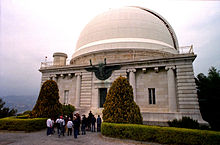 View of the Bischoffsheim cupola, main cupola of Nice Observatory
View of the Bischoffsheim cupola, main cupola of Nice Observatory
The Observatoire de Nice (Nice Observatory) is located on the summit of Mont Gros. The observatory was initiated in 1879 by the banker Raphaël Bischoffsheim. The architect was Charles Garnier, and Gustave Eiffel designed the main dome.
The 76-cm (30-inch) refractor telescope that became operational in 1888 was at that time the world's largest telescope. It was outperformed one year later by the 36-inch (91-cm) refractor at the Lick Observatory at University of California, Santa Cruz.
As a scientific institution, the Nice Observatory no longer exists. It was merged with CERGA in 1988 to form the Observatoire de la Côte d'Azur.
Culture
Nice is one of the oldest human settlements in the world. Terra-Amata, an archaeological site dating from the Lower Palaeolithic age, is situated near Nice. Nice itself was established by the ancient Greeks. There was also an independent Roman city, Cemenelum, near Nice, where the hill of Cimiez is located. It is an archaeological site with treasures, of which only a small part has been excavated. The excavated site includes thermal baths, arenas and Roman road.
Since the 2nd century AD, the light of the city has attracted many famous painters and sculptors such as Chagall, Matisse, Niki de Saint Phalle, Klein, Arman and Sosno. Nice inspired many composers and intellectuals in different countries e.g. Berlioz, Rossini, Nietzsche etc.
Nice also has numerous museums of all kinds: Musée Marc Chagall, Musée Matisse (arenas of Cimiez containing Roman ruins), Musée des Beaux-Arts Jules Chéret, Musée international d'Art naïf Anatole Jakovsky, Musée Terra-Amata, Museum of Asian Art, Musée d'art moderne et d'art contemporain which devotes much space to the well-known École of Nice ”), Museum of Natural History, Musée Masséna, Naval Museum and Galerie des Ponchettes.
Being a vacation resort, Nice hosts many festivals throughout the year, such as the Carnaval de Nice and the Nice Jazz Festival.
Nice has a distinct culture due to its unique history. The local language Niçard (Nissart) is an Occitan dialect (but some Italian scholars argue that it is a Ligurian dialect). It is still spoken by a substantial minority. Strong Italian and (to a lesser extent) Corsican influences make it more intelligible than other extant Provençal dialects.
In the past, Nice welcomed many immigrants from Italy (who continue to make up a large proportion of the population), as well as Spanish and Portuguese immigrants. However, in the past few decades immigration has been opened to include immigrants from all over the world, particularly those from former Northern and Western African colonies, as well as southeast Asia. Traditions are still alive, especially in folk music and dances. The most famous dance is the farandole.
Cuisine
The cuisine of Nice is especially close to those of Provence but also Liguria and Piemont and uses local ingredients (olive oil, anchovies, fruit and vegetables) but also those from more remote regions, in particular from Northern Europe, because ships which came to pick up olive oil arrived full of food products, such as dried haddock.
Nice has a few local dishes. There is a local tart made with onions and anchovies (or anchovy paste), named "Pissaladière". Socca is a type of pancake made from chickpea flour. Farcis niçois is a dish made from vegetables stuffed with breadcrumbs; and salade niçoise is a tomato salad with green peppers of the "Corne" variety, baked eggs, tuna or anchovies and olives.
Local meat comes from neighbouring valleys, such as the sheep of Sisteron. Local fish, such as mullets, bream, sea urchins, and anchovies (alevins) are used to a great extent, so much so that it has given birth to a proverb: "fish are born in the sea and die in oil"[citation needed].
Examples of Niçois specialties include:
- Beignets de fleurs de courgettes
- Ratatouille
- Pichade
- Pissaladière
- Pan-bagnat
- Socca
- Soupe au pistou
- Tourte de blettes
- Daube
- Farcis
- Salade niçoise
Education
- University of Nice Sophia Antipolis
- Université Pierre et Marie Curie
- Institut Eurécom
- École des hautes études commerciales du nord
- Villa Arson
- ESRA film school
International relations
Further information: List of twin towns and sister cities in FranceNotable people
- Mansour Assoumani – footballer
- Johan Audel – footballer
- Thierry Audel – footballer
- Surya Bonaly – figure skater
- Dominic Howard – Drummer for Muse currently lives in Nice
- Hugo Lloris – footballer
- Franck Matingou – footballer
- Yassin Moutaouakil – footballer
- Dominique Jean-Zéphirin footballer
- Gilles Simon – tennis player
- Alizé Cornet – tennis player
See also
References
- ^ Demographia: World Urban Areas, March 2010
- ^ Ruggiero, Alain, ed (2006). Nouvelle histoire de Nice. Toulouse: Privat. pp. 17–18. ISBN 978-2708983359.
- ^ Luc, Thevenon (1993). Nice, cité d'histoire, ville d'art. Nice: Serre. ISBN 978-2864101956.
- ^ Alain Ruggiero, op. cit., p. 137
- ^ "Nice, France travel. Comprehensive guide to Nice". Europe-cities.com. http://www.europe-cities.com/en/573/france/nice/. Retrieved 3 April 2011.
- ^ Un savoir-faire et un équipement complet en matière d’accueil[dead link], site de la CANCA
- ^ Les chiffres clés du tourisme à Nice[dead link], site municipal
- ^ "Union des aéroports français – Résultats d'activité des aéroports français 2007 – Trafic passagers 2007 classement – page 8" (PDF). http://www.aeroport.fr/fichiers/stats_2007.pdf. Retrieved 3 April 2011.
- ^ "Le Nouveau venu" (in French). Musée de Paléontologie Humaine de Terra Amata. http://www.musee-terra-amata.org/francais/prehistoire/origine4.htm. Retrieved 5 March 2009.
- ^ A. G. Wintle; M. J: Aitken (July 1997). "Thermoluminescence dating of burnt flint: application to a Lower Paleolithic site, Terra Amata". Archaeometry 19 (2): 111–130. doi:10.1111/j.1475-4754.1977.tb00189.x. http://www.bcin.ca/Interface/openbcin.cgi?submit=submit&Chinkey=51437.
- ^ "The Chsteau of Villeneuve-Loubet". Villeneuve-Loubet Guide and Hotels. http://villeneuveloubethotelreservation.com/articles/the-chateau-of-villeneuve-loubet. Retrieved 30 September 2009.
- ^ Léon Poliakov, La conditions des Juifs sous l'occupation italienne, Paris, CDJC, 1946 and bibliographies of Angelo Donati and Père Marie-Benoît
- ^ a b c d e f Ralph Schor (Edited by), Dictionnaire historique et biographique du comté de Nice(Historical and biographical dictionary of the County of Nice), Nice, Serre, 2002, ISBN 978-2864103660, pp.22–23 (French)
- ^ "Weather Information for Nice". June 2011. http://www.worldweather.org/062/c00902.htm.
- ^ "Climat en France" – Météo France
- ^ 2009 traffic details from Nice airport website[dead link]
- ^ "French Riviera train for Russia". BBC News. 23 September 2010. http://www.bbc.co.uk/news/world-europe-11400917. Retrieved 24 September 2010.
- ^ "Dates et chiffres clés / La ligne 1 / Accueil - Tramway de la Communauté Urbaine Nice Côte d'Azur" (in (French)). Tramway.nice.fr. http://tramway.nice.fr/La-ligne-1/Dates-et-chiffres-cles. Retrieved 2011-09-15.
- ^ Villages in the communes of today's Cassini the site of the Ecole des Hautes Etudes en Sciences Sociales.
- ^ Evolution and population structure (from 1968 to 2007) on the site of Insee.
Sources
- INSEE
 This article incorporates text from a publication now in the public domain: Chisholm, Hugh, ed (1911). Encyclopædia Britannica (11th ed.). Cambridge University Press.
This article incorporates text from a publication now in the public domain: Chisholm, Hugh, ed (1911). Encyclopædia Britannica (11th ed.). Cambridge University Press. This article incorporates text from a publication now in the public domain: Herbermann, Charles, ed (1913). "Nice". Catholic Encyclopedia. Robert Appleton Company.
This article incorporates text from a publication now in the public domain: Herbermann, Charles, ed (1913). "Nice". Catholic Encyclopedia. Robert Appleton Company.
External links
- Official website (French)
- Visitors and Convention Bureau Nice (French) (English)
- Nice travel guide from Wikitravel
- Nice at the Open Directory Project
Communes of the Alpes-Maritimes department 
Aiglun · Amirat · Andon · Antibes · Ascros · Aspremont · Auribeau-sur-Siagne · Auvare · Bairols · Le Bar-sur-Loup · Beaulieu-sur-Mer · Beausoleil · Belvédère · Bendejun · Berre-les-Alpes · Beuil · Bézaudun-les-Alpes · Biot · Blausasc · La Bollène-Vésubie · Bonson · Bouyon · Breil-sur-Roya · Briançonnet · La Brigue · Le Broc · Cabris · Cagnes-sur-Mer · Caille · Cannes · Le Cannet · Cantaron · Cap-d'Ail · Carros · Castagniers · Castellar · Castillon · Caussols · Châteauneuf-d'Entraunes · Châteauneuf-Grasse · Châteauneuf-Villevieille · Cipières · Clans · Coaraze · La Colle-sur-Loup · Collongues · Colomars · Conségudes · Contes · Courmes · Coursegoules · La Croix-sur-Roudoule · Cuébris · Daluis · Drap · Duranus · Entraunes · L'Escarène · Escragnolles · Èze · Falicon · Les Ferres · Fontan · Gars · Gattières · La Gaude · Gilette · Gorbio · Gourdon · Grasse · Gréolières · Guillaumes · Ilonse · Isola · Lantosque · Levens · Lieuche · Lucéram · Malaussène · Mandelieu-la-Napoule · Marie · Le Mas · Massoins · Menton · Mouans-Sartoux · Mougins · Moulinet · Les Mujouls · Nice · Opio · Pégomas · Peille · Peillon · La Penne · Péone · Peymeinade · Pierlas · Pierrefeu · Puget-Rostang · Puget-Théniers · Revest-les-Roches · Rigaud · Rimplas · Roquebillière · Roquebrune-Cap-Martin · Roquefort-les-Pins · Roquesteron · Roquestéron-Grasse · La Roquette-sur-Siagne · La Roquette-sur-Var · Roubion · Roure · Le Rouret · Saint-André-de-la-Roche · Saint-Antonin · Saint-Auban · Saint-Blaise · Saint-Cézaire-sur-Siagne · Saint-Dalmas-le-Selvage · Sainte-Agnès · Saint-Étienne-de-Tinée · Saint-Jean-Cap-Ferrat · Saint-Jeannet · Saint-Laurent-du-Var · Saint-Léger · Saint-Martin-d'Entraunes · Saint-Martin-du-Var · Saint-Martin-Vésubie · Saint-Paul-de-Vence · Saint-Sauveur-sur-Tinée · Saint-Vallier-de-Thiey · Sallagriffon · Saorge · Sauze · Séranon · Sigale · Sospel · Spéracèdes · Tende · Théoule-sur-Mer · Thiéry · Le Tignet · Toudon · Touët-de-l'Escarène · Touët-sur-Var · La Tour · Tourette-du-Château · Tournefort · Tourrette-Levens · Tourrettes-sur-Loup · La Trinité · La Turbie · Utelle · Valbonne · Valdeblore · Valderoure · Vallauris · Venanson · Vence · Villars-sur-Var · Villefranche-sur-Mer · Villeneuve-d'Entraunes · Villeneuve-Loubet
Categories:- Nice
- Communes of Alpes-Maritimes
Wikimedia Foundation. 2010.

